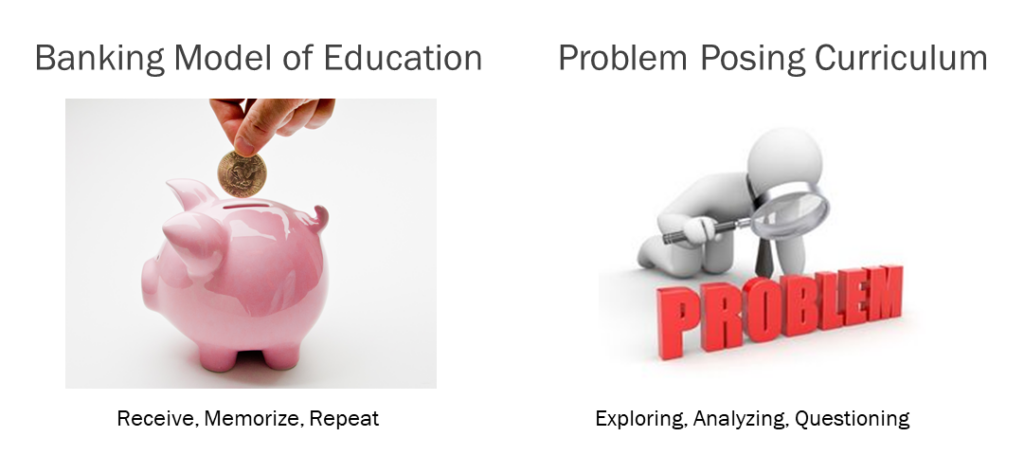A start of a new term means new discussions about teaching, learning, and technology. In the first week of my CURR 5018 course, I ask my students to write statements about the relationship between teaching, learning, and technology. Last October, my students’ discussions inspired me to reconsider my beliefs about teaching, learning, and technology, which I closely connect to creativity. This term, in relationship to Martin Luther King Day, I have been thinking about how our beliefs about what learning is can impact systemic inequity.
Language and Metaphors
The language we use to express our ideas impacts how we think and act. We often use metaphors to help us quickly connect and understand ideas. For example, early iTunes icons included a compact disc in the background, helping users understand that the program was for storing and playing music.
Some metaphors are so embedded into our language that they become automatic. For example, Michael Reddy explored metaphors we use for communication. He described a “conduit” metaphor, where communication is transferring ideas between things: We
- make our ideas come across
- put our thoughts down on paper
- hope our message went through
It takes some real mental gymnastics to even be aware of the metaphor. Can our ideas be replicated and moved across space? Can we write thoughts? What are we trying to get the message through? Even my questions here fail to escape the conduit metaphor.
Reddy argued that our struggles in communication are the result of the conduit metaphor is ineffective. We expect our ideas to duplicate exactly as they are, and when they don’t, we become frustrated.
Metaphors for Teaching and Learning
We often use a similar type of metaphor for education: teaching and learning become giving and acquiring. Teachers give knowledge; students receive and retain knowledge. We talk about “knowledge acquisition” and “concept development.” It is the acquisition metaphor for learning.
(Note: The use of the term “acquisition metaphor” comes from work by Ana Sfard, who contrasts acquisition with the “participation metaphor,” where learning is about becoming part of something, learning to participate in a community, or becoming a part of a whole.)
The acquisition metaphor suggests a type of ownership over something. Teaching and learning become a change in ownership. Knowledge is a commodity. Thus, it can be bought and sold, and stored in university credits, dividing the haves from the have-nots.
A Problem…
The problem (according to…uh…me!) is that thinking and acting from a knowledge acquisition perspective fails to meet the needs of our world: our “post-truth” era of “fake news,” social media, and vast quantities–and variable qualities–of information. Rather than investigating and engaging with the world, we become passive receptors of information. If we receive conflicting reports, we choose whichever best matches the beliefs we already hold instead of questioning the basis of those beliefs and considering there might be other perspectives. We are simply “acquiring knowledge.”
I’m not the only one to question the effects of acquisition metaphor of learning. Paulo Freire–known for developing the ideas behind what is called critical pedagogy–described something similar, what he called a “banking model” of education, where we simply place our ideas in the heads of others (I love the cartoon in this article about the banking model!). He pushed for a move to a “problem posing curriculum,” where learners explore, investigate, question assumptions, and take action to address inequities. They are invited to critique what is considered “normal,” perhaps coming to see the systemic inequities of their community.

What Can New Technologies Do?
Critical Digital Pedagogy applies critical pedagogy to the networked society we participate in. Jesse Stommel explained:
A Critical Digital Pedagogy demands that open and networked educational environments must not be merely repositories of content. They must be platforms for engaging students and teachers as full agents of their own learning.
from https://hybridpedagogy.org/critical-digital-pedagogy-definition/
This perspective encourages us to move past an acquisition metaphor, towards a view of learning as inquiry, critique, and action. The internet has magnified our ability to communicate and participate in a global society, giving a voice to those who traditionally have been silenced. Let’s focus on these creative uses of technologies, giving students a powerful platform for investigation, creation, and action.
References
Freire, P. (1970). Pedagogy of the oppressed (M. B. Ramos, trans.). Continuum.
Reddy, M. J. (1993). The conduit metaphor: A case of frame conflict in our language about language. In A. Ortony (Ed.), Metaphor and thought (pp. 164–201). Cambridge University Press. https://doi.org/10.1017/cbo9781139173865.012
Sfard, A. (1998). On two metaphors for learning and the dangers of choosing just one. Educational Researcher , 27(2), 4–13. http://www.jstor.org/stable/1176193